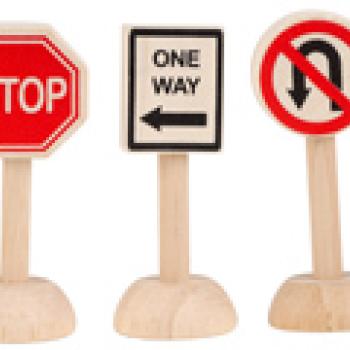Reading Signs and Labels

- Preview |
- Get Started |
- Comments
Activity Description
These activities will have children reading signs, logos, brand names, and other words all over their home and community. Begin the process by reading signs and labels at home. If you have computer access, explore street signs online. And when the children are out in the community together-while driving, going for a walk, or waiting for the bus, read signs, logos, and other words you see. It's the perfect activity to try any place!
Why This Is Helpful
These activities encourage children to see themselves as readers by discovering all of the words in their home and community that they are already capable of reading. As they collect and read these words, they will recognize how many different things they can read. By reading and exploring words they see every day, children come to see themselves as readers, genuine members of the "literacy club."
This activity was modified from the ReadWriteThink lesson plans "From Stop Signs to the Golden Arches: Environmental Print."
What You Need
- Items labeled with words (such as cans of food, magazines, and fast food containers)
- Google Image Search Instructions
- Computer and Internet access
- Online Street Sign Gallery
Here's What To Do
Identifying Everyday Labels and Words
- Gather examples of labels and logos with the child. You can choose from product packaging (i.e., cereal boxes, soda cans), fast food containers, store bags, and magazines.
- Ask the child to identify each of them. Ask the child how he can "read" the signs and artifacts. What clues is he using? Many children connect the words they see with a place, an experience, or an advertisement. Others may recognize letters or words. Still others can identify the logos, read them, and even be able to sing or say parts of the commercials connected to the various items of environmental print.
- Use the words on the items you have brought in to draw the child's attention to the letters and sounds. For example:
- How do you know this box says BAND-AID?
- What letter do you see at the beginning?
- What sounds does the letter b make?
- Is that the sound you hear at the beginning of BAND-AID?
- What is another word that begins with the same sound?
- Slowly segment the sounds made by each word and have the child call out the letter for each sound. Draw the child's attention to the different sounds that the same letter can make. For example:
- What other letters do you see in the word BAND-AID?
- What are the sounds that you hear in BAND-AID?
- Proceed in this manner with each of the items.
- Draw the child's attention to the fact that often a letter appears in different ways. For example, sometimes a letter might be written in cursive or in upper or lower case. Sometimes the same letter is big and red. The same letter can look different when it appears in different words.
- In the future, as you encounter items with labels or logos in your daily activities together, ask the child to identify the words and discuss what the item says if the child is unsure.
Exploring Street Signs
- If you have computer access, get started by visiting the Street Sign Gallery to review and discuss street signs before you go outside. If you don't have computer access, ask the child to name street signs he has seen or use pictures that you have gathered of street signs online, using the Google Image Search Instructions. You can also use pictures that you have gathered from books and magazines.
- After you've reviewed signs with the child, whenever you are outside walking or driving, ask the child to tell you what the different street signs say. Look for stop signs, railroad crossings, handicapped parking signs, school crossings, bike routes, and so on.
- If the child does not recognize the sign, share what it says and other places that you might see the sign.
- As you identify the signs, take advantage of the opportunity to also discuss what the street signs mean.
More Ideas To Try
- Have children collect some of the pictures, words, and logos they have seen. Make a scrapbook of them so they can share with others!
- Children can make Bingo boards and play Bingo with what they have discovered. Visit another Learning Beyond the Classroom activity "Let's Play Bingo!" to learn more.
Add new comment